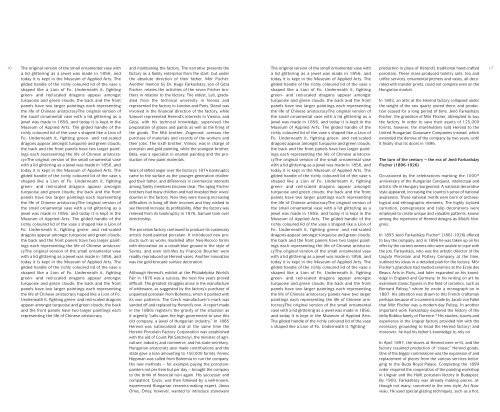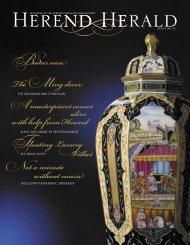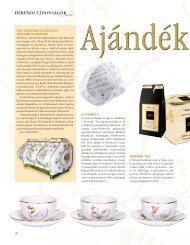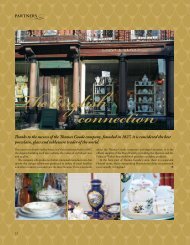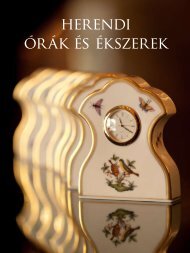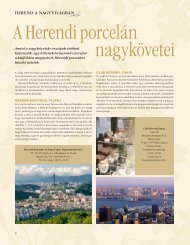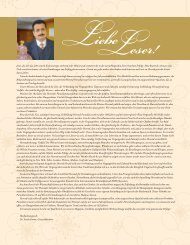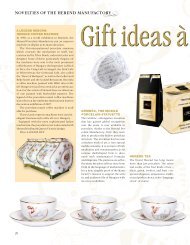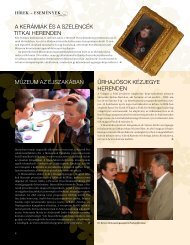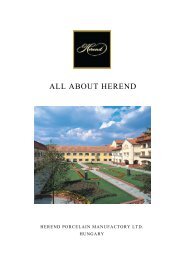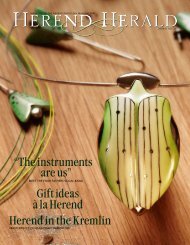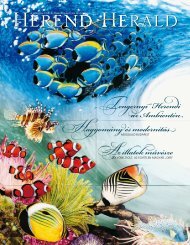LA PORCELAINE DE HEREND HEREND PORCELAIN
Genfi_32 q:Layout 1
Genfi_32 q:Layout 1
Create successful ePaper yourself
Turn your PDF publications into a flip-book with our unique Google optimized e-Paper software.
16 The original version of the small ornamental vase with<br />
a lid glittering as a jewel was made in 1856, and<br />
today it is kept in the Museum of Applied Arts. The<br />
gilded handle of the richly coloured lid of the vase s<br />
shaped like a Lion of Fo. Underneath it, fighting<br />
green- and red-scaled dragons appear amongst<br />
turquoise and green clouds; the back and the front<br />
panels have two larger paintings each representing<br />
the life of Chinese aristocracyThe original version of<br />
the small ornamental vase with a lid glittering as a<br />
jewel was made in 1856, and today it is kept in the<br />
Museum of Applied Arts. The gilded handle of the<br />
richly coloured lid of the vase s shaped like a Lion of<br />
Fo. Underneath it, fighting green- and red-scaled<br />
dragons appear amongst turquoise and green clouds;<br />
the back and the front panels have two larger paintings<br />
each representing the life of Chinese aristocracyvThe<br />
original version of the small ornamental vase<br />
with a lid glittering as a jewel was made in 1856, and<br />
today it is kept in the Museum of Applied Arts. The<br />
gilded handle of the richly coloured lid of the vase s<br />
shaped like a Lion of Fo. Underneath it, fighting<br />
green- and red-scaled dragons appear amongst<br />
turquoise and green clouds; the back and the front<br />
panels have two larger paintings each representing<br />
the life of Chinese aristocracyThe original version of<br />
the small ornamental vase with a lid glittering as a<br />
jewel was made in 1856, and today it is kept in the<br />
Museum of Applied Arts. The gilded handle of the<br />
richly coloured lid of the vase s shaped like a Lion of<br />
Fo. Underneath it, fighting green- and red-scaled<br />
dragons appear amongst turquoise and green clouds;<br />
the back and the front panels have two larger paintings<br />
each representing the life of Chinese aristocracyThe<br />
original version of the small ornamental vase<br />
with a lid glittering as a jewel was made in 1856, and<br />
today it is kept in the Museum of Applied Arts. The<br />
gilded handle of the richly coloured lid of the vase s<br />
shaped like a Lion of Fo. Underneath it, fighting<br />
green- and red-scaled dragons appear amongst<br />
turquoise and green clouds; the back and the front<br />
panels have two larger paintings each representing<br />
the life of Chinese aristocracy haped like a Lion of Fo.<br />
Underneath it, fighting green- and red-scaled dragons<br />
appear amongst turquoise and green clouds; the back<br />
and the front panels have two larger paintings each<br />
representing the life of Chinese aristocracy<br />
and maintaining the factory. The narrative presents the<br />
factory as a family enterprise from the start, but under<br />
the absolute direction of their father, Mór Fischer.<br />
Another memoir by Dr. Hugo Farkasházy, son of Géza<br />
Fischer, relates the activities of the seven Fischer bro -<br />
thers in relation to the factory. The eldest, Leó, graduated<br />
from the technical university in Vienna and<br />
represented the factory in London and Paris. Dezsô was<br />
involved in the financial direction of the factory, while<br />
Samuel represented Herend’s interests in Vienna, and<br />
Géza, with his technical knowledge, supervised the<br />
preparation of glazes and paints as well as the firing of<br />
the goods. The fifth brother, Zsigmond, oversaw the<br />
purchase of materials and records of the workers and<br />
their jobs. The sixth brother, Vilmos, was in charge of<br />
porcelain and gold painting, while the youngest brother,<br />
Béla, was a specialist in enamel painting and the production<br />
of new paint materials.<br />
Years of stifled anger over the factory’s 1874 bankruptcy<br />
came to the surface as the younger generation challen -<br />
ged their father, and differences in commercial interests<br />
among family members became clear. The aging Fischer<br />
brothers had many children and had invested their wives’<br />
dowries in the factory. Now they were having increasing<br />
difficulties in living off their incomes and they wished to<br />
see Herend increase its profitability. After the factory was<br />
relieved from its bankruptcy in 1876, Samuel took over<br />
directorship.<br />
The porcelain factory continued to produce its cus tomary<br />
artistic hand-painted porcelain. It introduced new pro -<br />
ducts such as works modelled after Neo-Rococo forms<br />
with decoration on a cobalt-blue ground in the style of<br />
Sevres, and even still-lifes by François Boucher were<br />
readily reproduced on Herend vases. Another innovation<br />
was the gold-brocade surface decoration.<br />
Although Herend’s exhibit at the Philadelphia World’s<br />
Fair in 1876 was a success, the next few years proved<br />
difficult. The greatest struggles arose in the manufacture<br />
of whiteware, as suggested by the factory’s purchase of<br />
unpainted porcelain from Bohemia, which it painted with<br />
its own patterns. The Czech manufacturer’s mark was<br />
sanded off and replaced by Herend’s own. A report made<br />
in the 1880s register’s the gravity of the situation as<br />
it urgently “calls upon the high government to save this<br />
old company, a jewel of Hungarian industry.” In 1885<br />
Herend was nationalized and at the same time the<br />
Herend Porcelain Factory Corporation was established<br />
with the aid of Count Pál Széchenyi, the minister of agriculture,<br />
industry and commerce, and his state secretary.<br />
Hungarian aristocrats also made contributions and the<br />
state gave a loan amounting to 150,000 forints. Ferenc<br />
Hippman was called from Bohemia to run the company.<br />
His new methods – for example paying the porcelainpainters<br />
not per item but per day – brought the company<br />
to the brink of financial ruin again. His successor and<br />
compatriot, Gruss, was then followed by a well-known,<br />
experienced Hungarian ceramics-making expert, János<br />
Örley. Örley, however, wanted to introduce stone ware<br />
The original version of the small ornamental vase with<br />
a lid glittering as a jewel was made in 1856, and<br />
today it is kept in the Museum of Applied Arts. The<br />
gilded handle of the richly coloured lid of the vase s<br />
shaped like a Lion of Fo. Underneath it, fighting<br />
green- and red-scaled dragons appear amongst<br />
turquoise and green clouds; the back and the front<br />
panels have two larger paintings each representing<br />
the life of Chinese aristocracyThe original version of<br />
the small ornamental vase with a lid glittering as a<br />
jewel was made in 1856, and today it is kept in the<br />
Museum of Applied Arts. The gilded handle of the<br />
richly coloured lid of the vase s shaped like a Lion of<br />
Fo. Underneath it, fighting green- and red-scaled<br />
dragons appear amongst turquoise and green clouds;<br />
the back and the front panels have two larger paintings<br />
each representing the life of Chinese aristocracyThe<br />
original version of the small ornamental vase<br />
with a lid glittering as a jewel was made in 1856, and<br />
today it is kept in the Museum of Applied Arts. The<br />
gilded handle of the richly coloured lid of the vase s<br />
shaped like a Lion of Fo. Underneath it, fighting<br />
green- and red-scaled dragons appear amongst<br />
turquoise and green clouds; the back and the front<br />
panels have two larger paintings each representing<br />
the life of Chinese aristocracyThe original version of<br />
the small ornamental vase with a lid glittering as a<br />
jewel was made in 1856, and today it is kept in the<br />
Museum of Applied Arts. The gilded handle of the<br />
richly coloured lid of the vase s shaped like a Lion of<br />
Fo. Underneath it, fighting green- and red-scaled<br />
dragons appear amongst turquoise and green clouds;<br />
the back and the front panels have two larger paintings<br />
each representing the life of Chinese aristocracyThe<br />
original version of the small ornamental vase<br />
with a lid glittering as a jewel was made in 1856, and<br />
today it is kept in the Museum of Applied Arts. The<br />
gilded handle of the richly coloured lid of the vase s<br />
shaped like a Lion of Fo. Underneath it, fighting<br />
green- and red-scaled dragons appear amongst<br />
turquoise and green clouds; the back and the front<br />
panels have two larger paintings each representing<br />
the life of Chinese aristocracy panels have two larger<br />
paintings each representing the life of Chinese aristocracyThe<br />
original version of the small ornamental<br />
vase with a lid glittering as a jewel was made in 1856,<br />
and today it is kept in the Museum of Applied Arts.<br />
The gilded handle of the richly coloured lid of the vase<br />
s shaped like a Lion of Fo. Underneath it, fighting<br />
production in place of Herend’s traditional hand-crafted<br />
porcelain. These mass-produced toiletry sets, tea and<br />
coffee services, ornamental pitchers and vases, all decorated<br />
with transfer prints, could not compete even on the<br />
Hungarian market.<br />
In 1892, an attic at the Herend factory collapsed under<br />
the weight of the raw quartz stored there, and production<br />
ceased for a long period of time. Jenô Farkasházy<br />
Fischer, the grandson of Mór Fischer, attempted to buy<br />
the factory. In order to save their assets of 125,000<br />
forints, however, the shareholders sold Herend to the<br />
United Hungarian Glassware Companies instead, which<br />
extended the demise of the company by two years, until<br />
it finally shut its doors in 1896.<br />
The turn of the century – the era of Jenô Farkasházy<br />
Fischer (1896-1926)<br />
Occasioned by the celebrations marking the 1000 th<br />
anniversary of the Hungarian Conquest, intellectual and<br />
artistic life in Hungary burgeoned. A national decorative<br />
style appeared, increasing the country’s sense of national<br />
awareness. These national motifs were born of archaeological<br />
and ethnographic elements. The highly stylized<br />
carnation, pomegranate and tulip decorations were<br />
employed to create unique and valuable patterns, known<br />
among the repertoire of Herend designs as Motifs Hongrois.<br />
In 1893 Jenô Farkasházy Fischer 4 (1861-1926) offered<br />
to buy the company, and in 1896 he was taken up on his<br />
offer by the current owners who were unable to cope with<br />
the job. Farkasházy, who was the artistic director of the<br />
Ungvár Porcelain and Pottery Company at the time,<br />
outlined his ideas in a detailed plan for the factory. Mór<br />
Fischer’s grandson had studied ceramics at the Ecole des<br />
Beaux Arts in Paris, and later expanded on his knowledge<br />
in England and Germany. In his writing on art he<br />
examined classic figures in the field of ceramics, such as<br />
Bernard Palissy, 5 whom he wrote a monograph on in<br />
1887. His attention was drawn to this French craftsman<br />
perhaps because of a comment made by Jacob von Falke<br />
that Mór Fischer was a modern-day Palissy. In another<br />
important work Farkasházy explored the history of the<br />
della Robbia family of Florence. 6 His studies, travels and<br />
experience in the Ungvár factory provided him with the<br />
necessary grounding to head the Herend factory; and<br />
moreover, he had his father’s knowledge to rely on.<br />
In April 1897, the stoves at Herend were re-lit, and the<br />
factory resumed production of “classic” Herend goods.<br />
One of the bigger commissions was the expansion of and<br />
replacement of pieces from the various services be lon -<br />
ging to the Buda Royal Palace. Completing the 1899<br />
order required the cooperation of the painting workshop<br />
in Ungvár and the Hüllt porcelain factory in Budapest.<br />
By 1900, Farkasházy was already making pieces, although<br />
not many, conceived in the new style, Art Nouveau.<br />
He used special glazing techniques, such as a hot,<br />
17


